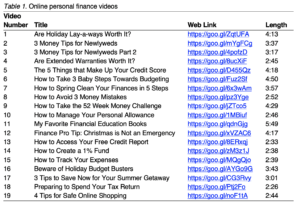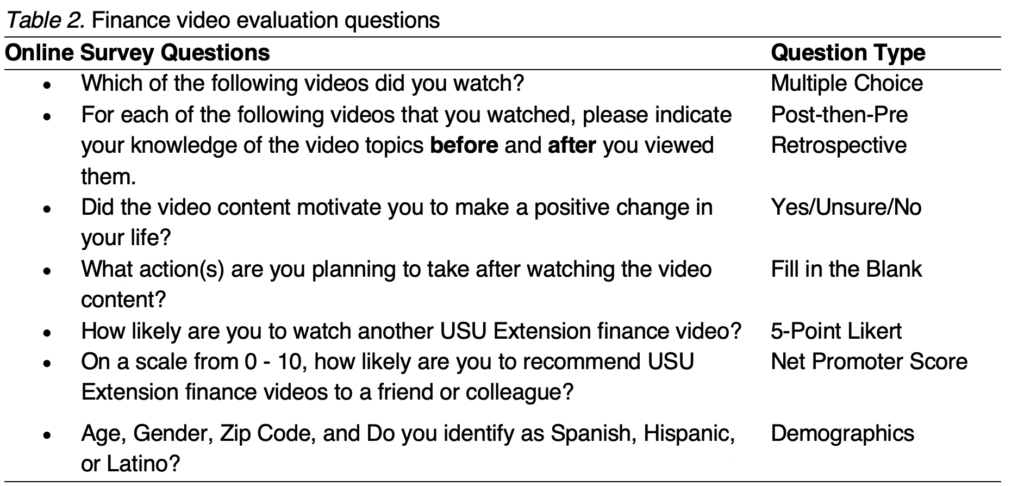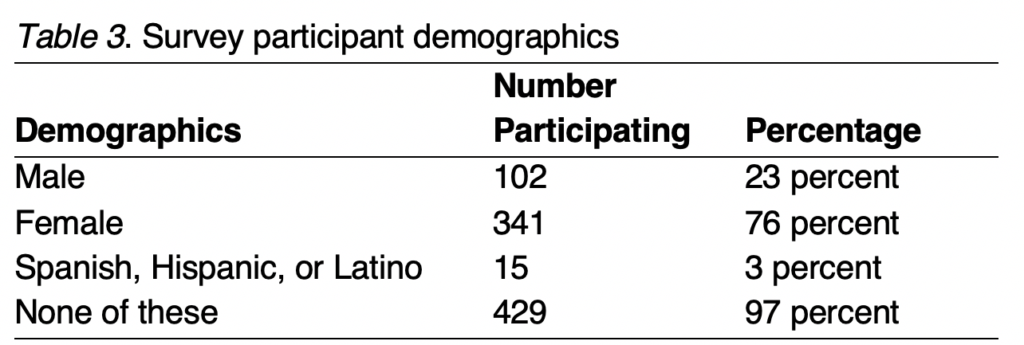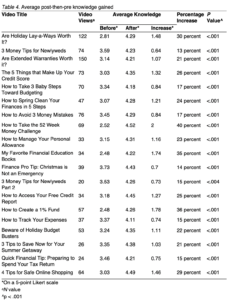Impacts of Delivering Finance Education Using Online Videos
Amanda Christensen
Utah State University
Andree’ Walker
Utah State University
Abstract
This article examines the benefits of using online videos for Extension educational outreach. In the digital age, as face-to-face engagement with Extension programming decreases, Extension professionals can still deliver research-based, reliable information to communities in new and engaging ways. Nineteen personal finance videos were created and posted to online platforms such as Extension’s YouTube and Facebook pages on topics such as budgeting, credit management, savings, personal allowance, holiday spending, tips for newlyweds, and so forth. The videos had 12,955 views in all 50 states and 27 countries. The positive impacts discussed show how Extension can successfully adapt peer-reviewed material and remain a relevant source of trustworthy information in the digital age. Implications for Extension are also discussed.
Keywords: educational video, financial literacy, on-line video, personal finance, YouTube
Introduction
Cooperative Extension patrons prefer accessing research-based information digitally (Langworthy, 2017). Digital video content can facilitate behavior change according to previous research by Ramsay, Holyoke, Branen, and Fletcher (2012), and the auditory signals and visual images transmitted through video are favored for adult learning (Dev, Blitch, Hatton-Bowers, Ramsay, & Garcia, 2018). Online videos reach more people than face-to-face classes (Kinsey & Henneman, 2011). Previous use of educational videos in Extension programming has successfully reached larger audiences at lower costs compared to traditional classroom methods (Case, Cluskey, & Hino, 2011). Further, Utah State University (USU) Extension reports nearly a 45 percent decline in face-to-face Extension contacts since 2014. Maintaining our presence among the next generation of Extension patrons means providing resources online. On-demand, online education options are increasingly essential to reach new audiences and keep the Cooperative Extension Service a viable resource for communities (Diem, Hino, Martin & Meisenbach, 2011).
Program description
In response to the demand for online content and decreasing attendance at personal finance-related Extension classes, we created and shared 19 personal finance educational videos addressing the most common questions asked of the authors by Extension patrons during classes, over the phone, and in person. The author wrote scripts for each video using research-based content. Writing scripts prior to filming ensures effective video elements such as keeping video length under 5 minutes, conveying a simple message, and depicting realistic scenarios (Dev et al., 2018).
The purpose of these engaging, 2- to 5-minute educational videos was to share peer-reviewed, research-based content, encourage viewers to make a positive change, increase awareness of additional Extension resources, and add to the existing online video library. A full family finance video playlist is available on Utah State University Extension’s YouTube channel. Individual video information is in Table 1.

[Alt tag content for Table 1: Title, web link, and length of individual personal finance videos.]
Prior to filming, content experts reviewed scripts submitted for peer review through an online program called FastTrack. Reviewers provided feedback, and edited scripts were resubmitted for final approval. Peer review of the video scripts prior to filming ensured the quality of the research-based content in the video by allowing colleagues to weigh in, similar to reviewing a fact sheet. This process guaranteed the integrity of the content and Cooperative Extension’s reputation as a trusted source for research-based information while filling the need for program delivery on digital platforms.
Next, videos were self-filmed at an in-home studio, in batches, and edited using existing computer software. A few props were purchased but no funds were spent to film or edit content. Video equipment, including a camera, lights, and microphone, was available because of a previous professional development grant. A final video file was sent to the USU Extension marketing team who added the proper wordmark and uploaded the finished video to YouTube.
USU Extension’s marketing department promoted the videos in partnership with the video author and other faculty members. E-newsletters, blog posts, and multiple social media platforms encouraged viewing. Initial efforts to share videos resulted in 12,955 views (YouTube/Facebook) and 6,869 minutes watched in 50 states and 27 countries on USU Extension’s YouTube Channel (12,975 subscribers).
Evaluation
Upon approval from the Institutional Review Board, we created a Qualtrics survey to evaluate the financial literacy videos and collect feedback on future videos. The survey questions included multiple choice, fill in the blank, retrospective “post-then-pre” and demographic questions. Participants responded regarding videos watched, perceived knowledge gained, behavior changes they planned to make because of the video content, likelihood of watching another video, and the likelihood of recommending the finance videos to a friend. Survey question samples are listed in Table 2.

[Alt tag content for Table 2: Specific online survey questions and question type.]
Participation in the survey was voluntary, and we advertised through USU electronic mailing lists, social media, Extension educational programming, e-newsletters, blog posts, etc. We provided an incentive for participation with a prize drawing for one of three Amazon Echo 2nd Generation devices. The survey was open from November to December of 2017, and 484 participants collectively viewed our 19 personal finance videos 1,102 times. Table 3 shows demographic information about participants. We did not include a question about how the participants accessed the survey link and cannot make recommendations as to best platforms for survey dissemination.

[Alt tag content for Table 3: Gender and race demographics of survey participants.]
Impacts
Survey results (n = 484) indicated a gain in financial knowledge and intended behavior change. Responding to a retrospective post-then-pre knowledge question, participants indicated an average 23 percent increase in overall reported knowledge level about finance topics (from an average score of 3.16 to 4.31 out of 5).
Table 4 details before and after results of the post-then-pre retrospective survey for each video on a 5-point Likert scale. Knowledge increase is also shown as a percentage along with the p-value. T-tests were performed on each data set and all knowledge increases were shown to be statistically significant. The authors acknowledge that the increase in knowledge is a self-reported measure.

[Alt tag content for Table 4: Results of the post-then-pre, retrospective survey for each video on a 5-point Likert scale.]
In addition to gaining knowledge, 85 percent of respondents reported that they were inspired to watch an additional Utah State Extension finance video. Each participant watched an average of 2.27 videos. When asked about the likelihood of participants sharing this content with a friend, responses averaged an 8 out of 10 with 10 being the most likely and 1 being the least likely. Finally, 76 percent of respondents indicated motivation to make a positive change in their lives after watching the videos, listing the following examples of planned behavior changes:
- “Try the 52-week money challenge.”
- “Look at my budget and see if I can be more frugal.”
- “Talk with my husband about a personal allowance.”
- “I never thought of a revolving savings account and I love that idea, so I’m planning on setting one up.”
Findings show an increased knowledge of financial topics, motivation to make a positive financial change, desire to watch more personal finance videos, and desire to share videos with friends — further indicating the value of on-line educational materials.
Implications for Extension
On-line educational videos extend the reach of Cooperative Extension beyond local, face-to-face contacts. Educational videos provide an innovative, convenient way to reach new and existing audiences with research-based information, empowering them to make informed choices to improve their lives.
Continued research. Future steps for continued research include embedding links in all YouTube videos for ongoing data collection, distributing 6-month follow-up surveys to those who agreed to participate in the initial survey, and sharing this model with additional faculty. Modifying and collecting data for additional online endeavors such as live question-and-answer sessions or short, virtual presentations on social media sites, webinars, and so forth is also encouraged. Efforts to collect additional data on innovative programs will further improve on-line Extension programming.
Expanding reach. Extension professionals need not shy away from repurposing scholarly work, presentations, and programs for online audiences. Reach and impact information of online content is extremely measurable, easily collected and can be disseminated the same as traditional scholarly work. For the success of tomorrow’s Cooperative Extension, today’s Extension professional must embrace efforts to reach online audiences with peer-reviewed content. Expanding our reach to online audiences cannot lead to diluted or weak material. We can share online what we share in person and still keep the integrity of our content through the peer-review process. This peer-reviewed, research-based material makes Extension unique and keeps us at the forefront for trusted, educational content.
Duplicating success. Further implications include program duplication. While the finance videos affected viewers positively, the program design also affected our larger state Extension system. To date, two other faculty members replicated this method in their own disciplines (relationships and horticulture), creating their own YouTube videos. Additionally, the survey has been modified to use with viewers after live Facebook events. The success of this program, and strategies for duplication, were shared with 45 state Extension faculty members at a social media training. Sharing best practices for duplicating successful on-line programming is important for the long-term success of the Cooperative Extension system. Some avenues for sharing successes include articles, scholarly presentations, blog posts, videos, and podcasts.
Summary
Understanding the impact that online videos have, both as a convenient, accessible educational resource and as a method to expand the reach of Extension resources, is integral to the future and relevancy of the Cooperative Extension system. As more and more people turn to the internet for resources and information, Cooperative Extension must adapt and meet users where they are or become irrelevant. By adapting to current and future audiences’ needs, and using their preferred digital-age tools, Extension professionals will continue to deliver research-based information that people trust. For the Cooperative Extension system to continue to show value to the public, our content must be timely, convenient, and accessible in a format that users seek. Peer-reviewed, online, educational videos are one successful way to reach the next generation of Cooperative Extension patrons.
References
Case, P., Cluskey, M., & Hino, J. (2011). Online Nutrition Education: Enhancing opportunities for limited-resource learners. Journal of Extension, 49(6). Article 6RIB5. Retrieved from https://joe.org/joe/2011december/rb5.php
Dev, D., Blitch, K., Hatton-Bowers, H., Ramsay, S., and Garcia, A. (2018). How to create videos for Extension education: An innovative five-step procedure. Journal of Extension 56(2). Article 21AW3. Retrieved from https://joe.org/joe/2018april/iw3.php
Diem, K., Hino, J., Martin, D., & Meisenbach, T. (2011). Is Extension ready to adopt technology for delivering programs and reaching new audiences? Journal of Extension, 49(6). Article 6FEA1. Retrieved from https://goo.gl/cif18L
Kinsey, J., & Henneman, A. C. (2011). Making your on-line video viral. Journal of Extension 49(4). Article 4TOT3. Retrieved from: http://www.joe.org/joe/2011august/tt3.php
Langworthy, L. (2017). Do you YouTube? The power of brief educational videos for Extension. Journal of Extension, 55(2). Article 2IAW1. Retrieved from https://goo.gl/YSy3Hy
Ramsay, S. A., Holyoke, L., Branen, L. J., & Fletcher, J. (2012). Six characteristics of nutrition education videos that support learning and motivation to learn. Journal of Nutrition Education and Behavior, 44(6), 614–617. doi:10.1016/j.jneb.2011.10.010
Utah State University Extension YouTube Channel. (2018, June 10). Personal Finance YouTube Playlist. Retrieved from https://goo.gl/CQePF6
